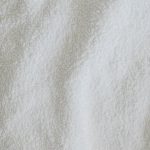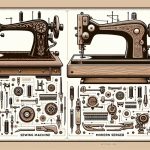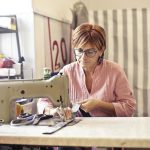If you've ventured into the world of garment construction, you've likely encountered the debate over serger versus overlock machines. Understanding the nuances between these two powerful tools is crucial for achieving professional-quality finishes on your projects.
Both machines excel at securing seams and preventing fraying, yet they possess distinct features that cater to specific stitching requirements. Delving into the differential feed mechanism, thread tension variations, and applications for different projects will illuminate the disparities between these machines.
By mastering the differences, you'll be empowered to select the most suitable machine for your sewing endeavors and elevate the quality of your creations.
Key Takeaways
- Serger machines are specifically designed for finishing edges and creating professional-looking seams, while overlock machines are more versatile and can be used for a variety of stitching techniques.
- Both serger and overlock machines have similar functions, such as trimming seam allowances and enclosing raw edges of fabric.
- Sergers are ideal for sewing activewear and knit fabrics, while overlocks are more versatile and can be used for a wider range of fabrics.
- Both serger and overlock machines require proper adjustments and practice to achieve professional-looking seams and secure stitches.
Understanding Serger Machines
When you're learning about serger machines, it's important to understand their specific functions and capabilities. Serger machine features include the ability to trim fabric edges, encase raw edges, and create professional-looking seams. These machines typically have multiple thread spools, allowing for the simultaneous use of different thread colors or types. Additionally, sergers can be used to sew decorative stitches and add gathering effects to fabric.
Understanding the benefits of serger machines is essential for anyone looking to elevate their sewing projects. One of the key advantages is the ability to finish edges quickly and neatly, preventing fraying and giving garments a polished look. Moreover, sergers are adept at creating durable seams that can withstand stretching and frequent wear, making them ideal for sewing activewear and knit fabrics. The efficiency and precision of serger machines also contribute to a faster and more professional sewing process, saving time and effort while producing high-quality results.
In mastering the use of serger machines, familiarity with their features and the advantages they offer is crucial for achieving impeccable and durable sewing outcomes.
Understanding Overlock Machines
To understand overlock machines, you should be aware of their similarities to serger machines and their specific functions in garment construction. Overlock machines and sergers are often used interchangeably, as they both excel at trimming seam allowances and enclosing the raw edges of fabric within a thread casing.
Overlock machines are essential for creating durable and neat seams, particularly in knitwear and woven fabrics. They're equipped with multiple thread cones that enable various stitching methods, such as mock safety stitches, overedge stitches, and cover stitches. These stitching methods contribute to the overall strength and flexibility of the seams, making them highly resistant to fraying and unraveling.
Additionally, overlock machines offer a range of seam finishing techniques, including rolled hems and flatlocking, which add a professional touch to garments. Understanding the capabilities of overlock machines allows for precise and efficient seam construction, resulting in high-quality, professionally finished clothing.
Stitching Techniques of Sergers
In mastering the stitching techniques of sergers, you'll discover their versatility and precision in creating professional seams and finishes.
The stitch length and stitch width are two essential factors that contribute to the quality and appearance of the serged seams. The stitch length refers to the distance between each stitch, and it can be adjusted based on the type of fabric and the desired seam effect. A shorter stitch length is suitable for lightweight fabrics, while a longer stitch length works well for heavier fabrics.
When it comes to stitch width, it determines how far the needles move from the edge of the fabric. By adjusting the stitch width, you can create different seam finishes such as rolled hems, flatlock seams, and decorative edges.
Understanding the interplay between stitch length and stitch width is crucial for achieving professional-looking and durable seams. With practice and experimentation, you can harness the full potential of sergers to elevate the quality of your sewing projects.
Stitching Techniques of Overlocks
When working with overlock machines, there are several essential aspects to master.
Firstly, you'll need to understand the stitch formation process. This involves knowing how the machine creates the stitches and how the threads interlock to secure the fabric edges.
Secondly, you'll need to make proper adjustments to thread tension. This is crucial for ensuring that the stitches are balanced and secure. Adjusting the tension correctly will prevent loose or tight stitches and contribute to a professional finish.
Lastly, it's important to be familiar with different stitch types and their uses. Overlock machines offer various stitch options, such as 3-thread, 4-thread, and rolled hem stitches. Knowing when and how to use each stitch type will allow you to achieve different seam finishes and effects on your projects.
Stitch Formation Process
When using an overlock machine, you'll form stitches by simultaneously trimming the fabric edge and enclosing it with a series of thread loops. This stitching process distinguishes overlock machines from other types of sewing machines.
Here are some key elements of the stitch formation process in overlock machines:
- Differential Feed: Adjusting the rate at which the fabric is fed through the machine can affect the final stitch quality.
- Thread Tension: Proper tension control ensures neat and secure stitches.
- Stitch Types: Overlock machines offer a variety of stitch options such as 4-thread, 3-thread, and rolled hem stitches.
- Stitch Length and Width: These settings allow for customization of stitch appearance and strength.
- Blade Position: The position of the cutting blade determines the amount of fabric being trimmed while stitching.
Thread Tension Adjustments
To achieve optimal stitching results with your overlock machine, adjust the thread tension according to the fabric and stitch type. Proper tension ensures balanced and neat stitches.
Begin by threading the machine following the manufacturer's instructions, making sure the threads are correctly placed in the tension discs and the tension dials are set to the recommended settings.
For light or medium-weight fabrics, a balanced tension setting usually works well. However, for heavier fabrics, you may need to adjust the tension to accommodate the thicker material.
If the stitch quality isn't satisfactory, experiment with small adjustments to the tension dials, ensuring that the threads are evenly tensioned.
Achieving the right tension is crucial for producing high-quality, professional-looking seams and edges with your overlock machine.
Stitch Types and Uses
You frequently use different stitch types and techniques with your overlock machine to create professional and durable seams and finishes. Understanding the various stitch variations and their decorative uses is crucial for achieving the desired outcome.
When it comes to fabric edge finishing and seam construction, mastering the following techniques will elevate the quality of your work:
- Overlock Stitch: Ideal for seaming and enclosing raw edges. It prevents fraying and provides a neat finish.
- Flatlock Stitch: Used for joining seams in a decorative and flat manner, commonly seen in sportswear and knitwear.
- Rolled Hem: Perfect for creating delicate, narrow hems on lightweight fabrics like chiffon or silk.
- Chain Stitch: Great for decorative purposes and creating strong, flexible seams.
- Cover Stitch: Essential for creating professional hems, especially on knit fabrics like t-shirts and activewear.
Mastering these stitching techniques will enhance your overlocking skills and allow you to produce top-quality garments.
Differential Feed Mechanism
The differential feed mechanism on a serger or overlock machine ensures that both layers of fabric are fed through at the same rate, preventing stretching or puckering. This mechanism allows you to adjust the feed ratio, which is the ratio between the movement of the front and rear feed dogs. By altering this ratio, you can effectively handle different types of fabric.
For instance, when working with stretchy or slippery fabrics, a differential feed setting of 1.3 or 1.5 can help prevent the fabric from becoming wavy or stretched out. On the other hand, for lightweight fabrics, setting the feed ratio closer to 1 can ensure smooth and even feeding.
Additionally, the differential feed mechanism plays a crucial role in managing stitch differentials. Stitch differential refers to the ratio between the movement of the feed dogs and the needle. By adjusting the feed ratio, you can regulate the stitch length and prevent issues such as puckering on lightweight fabrics or stretching on knits.
Understanding and effectively utilizing the differential feed mechanism empowers you to achieve professional-looking results across a diverse range of fabrics and sewing projects.
Thread Tension Variations
When comparing serger and overlock machines, it's essential to understand the differences in thread tension and the mechanisms for adjusting it.
The tension on a serger is typically more finely adjustable, allowing for precise control over the stitches.
On the other hand, overlock machines may have simpler tension systems that are easier to manage for beginners.
Serger Vs Overlock Tension
Proper tension control is crucial for achieving optimal stitch quality and thread balance while ensuring smooth fabric handling. Here are some key points to consider:
- Understand the fabric: Different fabrics require varying tension adjustments.
- Test on scrap fabric: Always test the stitch and tension settings on a scrap piece of fabric before starting on the actual project.
- Make incremental adjustments: When tweaking the tension, make small changes and test the stitch quality frequently.
- Keep a record: Note down the tension settings for different fabrics to save time in the future.
- Seek professional advice: If you're unsure about tension adjustments, consider consulting a professional or referring to the machine's manual.
Mastering tension control is essential for achieving professional results with your serger or overlock machine.
Adjusting Thread Tension
To achieve optimal stitch quality and thread balance on your serger or overlock machine, it's essential to adjust thread tension variations carefully and methodically.
When troubleshooting thread tension, start by ensuring that the machine is threaded correctly. Check that the threads are securely seated in the tension discs and that they pass through all the thread guides.
Next, adjust the tension dials according to the fabric and thread being used. For finer fabrics, decrease the tension, and for heavier fabrics, increase the tension. Remember to test the stitch on a scrap piece of fabric and make small adjustments as needed.
Additionally, consider the condition of the needles, as bent or dull needles can cause tension issues.
Applications and Project Suitability
Consider the types of projects you typically work on to determine whether a serger or overlock machine is better suited for your needs. When assessing project versatility, stitch options, fabric suitability, and finishing techniques, you can make a more informed decision about which machine will best suit your sewing needs.
- Project Versatility: Assess the range of projects you commonly work on and evaluate whether a serger or overlock machine offers the necessary features and capabilities for these projects.
- Stitch Options: Consider the specific stitch options required for your projects, such as rolled hems, flatlocking, or decorative stitches, and determine which machine provides these functionalities.
- Fabric Suitability: Evaluate the types of fabric you frequently use in your projects and determine whether a serger or overlock machine is better suited for handling these materials effectively.
- Finishing Techniques: Assess the finishing techniques you employ in your projects, such as seam finishing, edging, or hemming, and identify which machine aligns with these requirements.
- Professional Results: Consider the level of professionalism and precision you aim to achieve in your projects and choose a machine that can consistently deliver the desired results.
Frequently Asked Questions
Can a Serger or Overlock Machine Be Used for Embroidery or Decorative Stitching?
Yes, a serger can be used for embroidery techniques, but it has limitations. An overlock machine is better for decorative stitching since it has capabilities specifically designed for this purpose.
What Are the Differences in Maintenance and Cleaning Between a Serger and Overlock Machine?
To maintain your serger or overlock machine, regularly oil the moving parts and clean out lint build-up. Use a small brush to remove debris, and a soft cloth to wipe down the exterior. Follow the manufacturer's maintenance tips and cleaning techniques for best results.
Are There Specific Needles or Thread Types That Are Recommended for Use With Sergers or Overlock Machines?
For sergers and overlock machines, specific needle types and thread types are recommended. Tension adjustment and stitch length are crucial for achieving optimal results. Use appropriate needles and threads and adjust tension and stitch length accordingly.
Can a Serger or Overlock Machine Be Used to Sew Heavyweight Fabrics Such as Denim or Canvas?
Yes, a serger can handle heavyweight fabrics like denim. Adjust the differential feed and tension for optimal results. Overlock machines are also suitable for sewing canvas. Troubleshoot tension issues to ensure smooth, professional-looking seams.
Are There Any Special Considerations for Using a Serger or Overlock Machine With Stretchy or Knitted Fabrics?
When using a serger or overlock machine with delicate fabrics, it's crucial to adjust tension for stretchy materials. Prevent fabric puckering by ensuring proper settings and using appropriate needles. Practice on scraps to master handling knitted fabrics.
- Recycling Nonwoven Fabrics: Is It Possible? - July 11, 2025
- Recycling Nonwoven Fabrics: Is It Possible? - July 11, 2025
- Recycling Nonwoven Fabrics: Is It Possible? - July 11, 2025







